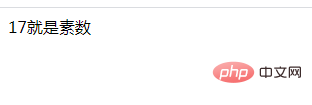 Backend Development
Backend Development
 PHP Problem
PHP Problem
 PHP Loop Learning 11: How to determine prime numbers, print prime numbers from 1 to 100, and count their numbers
PHP Loop Learning 11: How to determine prime numbers, print prime numbers from 1 to 100, and count their numbers
PHP Loop Learning 11: How to determine prime numbers, print prime numbers from 1 to 100, and count their numbers
In the previous article "PHP Loop Learning Ten: Determine the Number of Narcissus and Print the Number of All Narcissus", we will introduce to you how to determine the number of narcissus and use a loop to output the number of all narcissus. Method, let’s continue learning about PHP loops and introduce how to determine whether a number is a prime number and output a prime number from 1 to 100. Interested friends can learn about it~
First of all, let’s learn about it What are prime numbers?
Prime number (prime number) refers to a natural number that cannot be divided by other numbers except 1 and itself; if it can be divided by other numbers, it is called a composite number (stipulation) 1 is neither prime nor composite).
For example: the numbers 2, 3, 17, and 19 are all prime numbers. They can only be divided by 1 and themselves.
So if a number num (for example, 17) is given, how do we determine whether this number num is a prime number? Here are several methods to introduce to you:
Method 1: The simplest method is to find based on the definition of prime numbers
Thinking:
Prime numbers can only be divisible by 1 and itself, that is, they can only be divided by 2 times.
So we use loops to divide N by using every natural number greater than 1 and less than or equal to N, and count the number of times it is divided. If the number is greater than 2, it is not a prime number; if it is equal to 2, then is a prime number.
Let’s take a look at the implementation code:
<?php
header("content-type:text/html;charset=utf-8");
$num=17;
$count = 1;
for($i = 2; $i <= $num; $i++) {
if(($num % $i)== 0)
$count ++;
}
if($count == 2) {
echo $num . '就是素数<br/>';
}else{
echo $num . '不是素数<br/>';
}
?>Output result:

## Method 2:
Idea: Use a number to divide 2 tosqrt (this number) respectively. If it can be divided evenly, it means that the number is not a prime number, otherwise it is a prime number.
<?php
header("content-type:text/html;charset=utf-8");
$num=19;
$flag = 1;
for($i = 2; $i*$i <= $num; $i++) //能被2 - sqrt(i)整除的数
{
if($num % $i == 0)
{
$flag = 0;
break;
}
}
if($flag == 1) {
echo $num . '就是素数<br/>';
}else{
echo $num . '不是素数<br/>';
}
?>
How to give a range (such as 1~100) and output all prime numbers?
Do you want to use two loops? Based on the above for loop, just put a layer of for loop outside to control the range. Let’s take a look at the implementation code (directly using the code of method 2):<?php
header("content-type:text/html;charset=utf-8");
$count = 0;
for($k = 2; $k <= 100; $k++){ //从2开始,遍历到100
$flag = 1;
for($i = 2; $i*$i <= $k; $i++) {//能被2 - sqrt(i)整除的数
if($k % $i == 0)
{
$flag = 0;
break;
}
}
if($flag == 1) {
echo $k . '是素数<br/>';
$count ++;
}
}
echo '<br/>1~100间共有 '.$count." 个素数";
?>
$count is used. After each prime number is output, it increases by 1, so that we can count how many prime numbers there are between 1 and 100.
Recommended: 《PHP interview questions summary (collection)》
The above is the detailed content of PHP Loop Learning 11: How to determine prime numbers, print prime numbers from 1 to 100, and count their numbers. For more information, please follow other related articles on the PHP Chinese website!

Hot AI Tools

Undresser.AI Undress
AI-powered app for creating realistic nude photos

AI Clothes Remover
Online AI tool for removing clothes from photos.

Undress AI Tool
Undress images for free

Clothoff.io
AI clothes remover

Video Face Swap
Swap faces in any video effortlessly with our completely free AI face swap tool!

Hot Article

Hot Tools

Notepad++7.3.1
Easy-to-use and free code editor

SublimeText3 Chinese version
Chinese version, very easy to use

Zend Studio 13.0.1
Powerful PHP integrated development environment

Dreamweaver CS6
Visual web development tools

SublimeText3 Mac version
God-level code editing software (SublimeText3)

Hot Topics
 PHP 8.4 Installation and Upgrade guide for Ubuntu and Debian
Dec 24, 2024 pm 04:42 PM
PHP 8.4 Installation and Upgrade guide for Ubuntu and Debian
Dec 24, 2024 pm 04:42 PM
PHP 8.4 brings several new features, security improvements, and performance improvements with healthy amounts of feature deprecations and removals. This guide explains how to install PHP 8.4 or upgrade to PHP 8.4 on Ubuntu, Debian, or their derivati
 7 PHP Functions I Regret I Didn't Know Before
Nov 13, 2024 am 09:42 AM
7 PHP Functions I Regret I Didn't Know Before
Nov 13, 2024 am 09:42 AM
If you are an experienced PHP developer, you might have the feeling that you’ve been there and done that already.You have developed a significant number of applications, debugged millions of lines of code, and tweaked a bunch of scripts to achieve op
 How To Set Up Visual Studio Code (VS Code) for PHP Development
Dec 20, 2024 am 11:31 AM
How To Set Up Visual Studio Code (VS Code) for PHP Development
Dec 20, 2024 am 11:31 AM
Visual Studio Code, also known as VS Code, is a free source code editor — or integrated development environment (IDE) — available for all major operating systems. With a large collection of extensions for many programming languages, VS Code can be c
 Explain JSON Web Tokens (JWT) and their use case in PHP APIs.
Apr 05, 2025 am 12:04 AM
Explain JSON Web Tokens (JWT) and their use case in PHP APIs.
Apr 05, 2025 am 12:04 AM
JWT is an open standard based on JSON, used to securely transmit information between parties, mainly for identity authentication and information exchange. 1. JWT consists of three parts: Header, Payload and Signature. 2. The working principle of JWT includes three steps: generating JWT, verifying JWT and parsing Payload. 3. When using JWT for authentication in PHP, JWT can be generated and verified, and user role and permission information can be included in advanced usage. 4. Common errors include signature verification failure, token expiration, and payload oversized. Debugging skills include using debugging tools and logging. 5. Performance optimization and best practices include using appropriate signature algorithms, setting validity periods reasonably,
 How do you parse and process HTML/XML in PHP?
Feb 07, 2025 am 11:57 AM
How do you parse and process HTML/XML in PHP?
Feb 07, 2025 am 11:57 AM
This tutorial demonstrates how to efficiently process XML documents using PHP. XML (eXtensible Markup Language) is a versatile text-based markup language designed for both human readability and machine parsing. It's commonly used for data storage an
 PHP Program to Count Vowels in a String
Feb 07, 2025 pm 12:12 PM
PHP Program to Count Vowels in a String
Feb 07, 2025 pm 12:12 PM
A string is a sequence of characters, including letters, numbers, and symbols. This tutorial will learn how to calculate the number of vowels in a given string in PHP using different methods. The vowels in English are a, e, i, o, u, and they can be uppercase or lowercase. What is a vowel? Vowels are alphabetic characters that represent a specific pronunciation. There are five vowels in English, including uppercase and lowercase: a, e, i, o, u Example 1 Input: String = "Tutorialspoint" Output: 6 explain The vowels in the string "Tutorialspoint" are u, o, i, a, o, i. There are 6 yuan in total
 Explain late static binding in PHP (static::).
Apr 03, 2025 am 12:04 AM
Explain late static binding in PHP (static::).
Apr 03, 2025 am 12:04 AM
Static binding (static::) implements late static binding (LSB) in PHP, allowing calling classes to be referenced in static contexts rather than defining classes. 1) The parsing process is performed at runtime, 2) Look up the call class in the inheritance relationship, 3) It may bring performance overhead.
 What are PHP magic methods (__construct, __destruct, __call, __get, __set, etc.) and provide use cases?
Apr 03, 2025 am 12:03 AM
What are PHP magic methods (__construct, __destruct, __call, __get, __set, etc.) and provide use cases?
Apr 03, 2025 am 12:03 AM
What are the magic methods of PHP? PHP's magic methods include: 1.\_\_construct, used to initialize objects; 2.\_\_destruct, used to clean up resources; 3.\_\_call, handle non-existent method calls; 4.\_\_get, implement dynamic attribute access; 5.\_\_set, implement dynamic attribute settings. These methods are automatically called in certain situations, improving code flexibility and efficiency.





